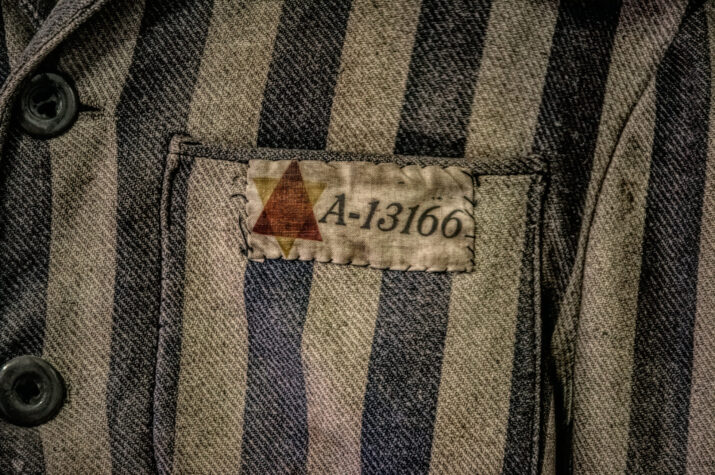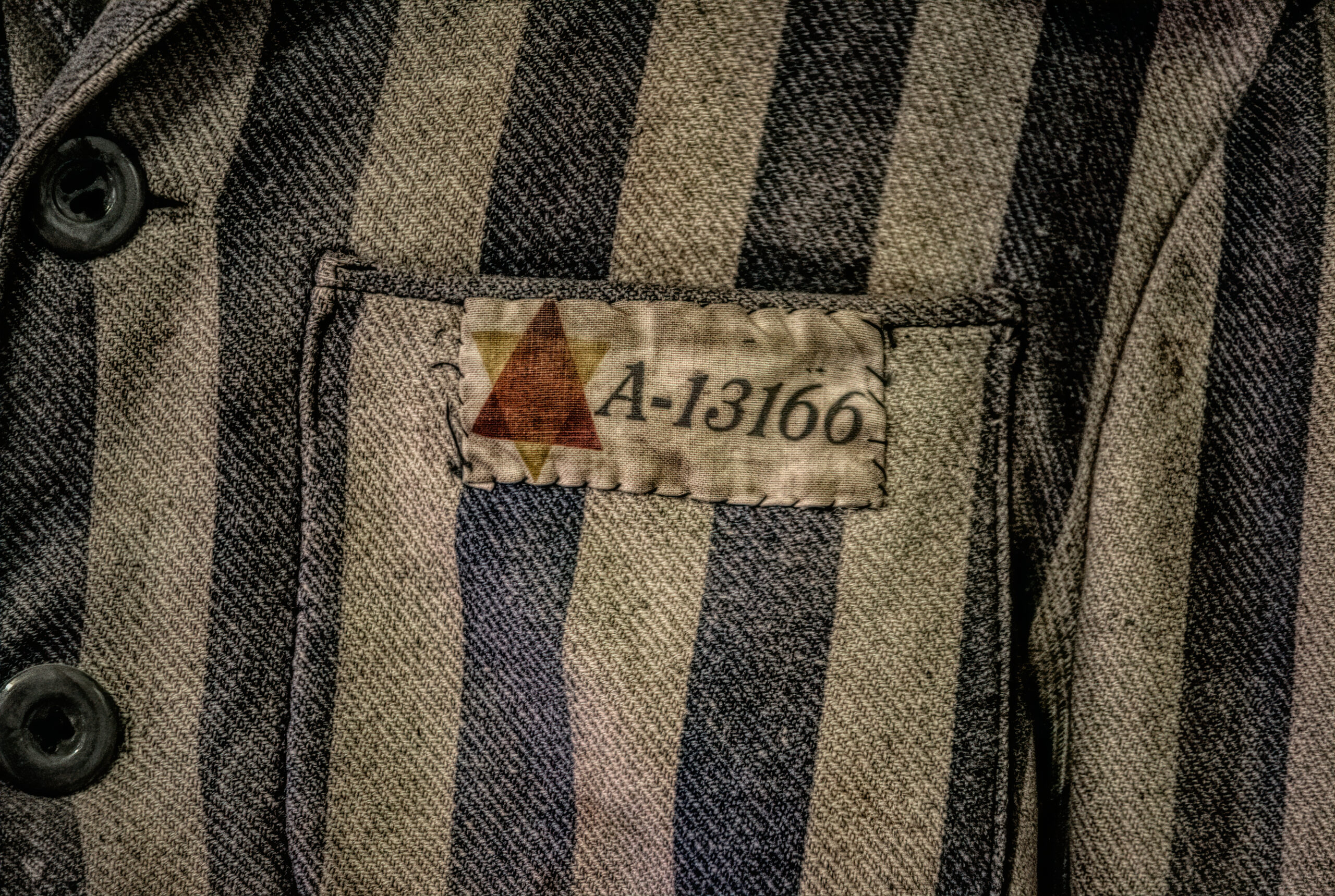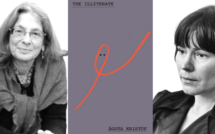

This syllabus is intended for face-to-face instruction.
This syllabus is an updated version of my advanced undergraduate/graduate course, The Holocaust, which ran most recently in the spring 2020 semester. It was interrupted by COVID-19 mediation measures around Week 7, which drove a course designed for classroom instruction online. With a few modifications, such as reducing Zoom meetings to once per week, prerecording lectures, and instituting real-time chatroom discussion forums, the course proved remarkably adaptable.
What follows is the syllabus from that course with assignments revised to incorporate some elements, including audio-visual sources, I adopted when the course went virtual. This iteration is nevertheless designed for a traditional classroom setting. To that end, I have included a glimpse of materials for use in the classroom but not assigned for homework: A Day in Warsaw, Paul Robeson singing Zot Nit Keynmol, and drone footage of Auschwitz-Birkenau.
Over the years, I have settled on a few books and films that I intend to keep in future versions of this course. The reading and viewing list, however, is still quite malleable. I was fortunate to have discovered Doris Bergen’s War and Genocide and Marion Kaplan’s Between Dignity and Despair quite early in my teaching career and will likely keep assigning them for some time. Patrick Desbois’ The Holocaust by Bullets is likewise an effective text, though an instructor could assign a couple of choice scanned chapters from it in order to open space for another reading, one of the omitted chapters from Between Dignity and Despair, or another brief unit on a dimension of the Shoah and the Nazi racial war more broadly that this syllabus overlooks. For the final text, I chose Primo Levi’s The Drowned and the Saved rather than a traditional Holocaust memoir in part because the course begins with some challenging philosophical material and in part because this text helps students make sense of Son of Saul, a film I showed for the first time in the spring semester and will likely use again. Inspired by my experiences running this class online, I also converted the final exam from an in-class pen-and-paper test to an online essay interpreting the material covered in the second half of the semester through Levi’s concept of the “gray zone.” This adjustment opens the final course meeting, which normally would be a dedicated review session, to further discussion about Levi and a brief introduction to Europe and the world after the Holocaust.
Course description
The Holocaust is a term that is frequently bandied about, but rarely fully understood. This is a problem. By analyzing the Holocaust and the Nazi ideology that underlay it, this course seeks a more sophisticated and informed understanding of these particularly fraught and complicated twentieth-century phenomena. In this pursuit, we will read and discuss a selection of primary and secondary written sources, films, photos, and other historical documents to grapple with the question of how so many Germans and other Europeans could turn so definitively against their Jewish neighbors in pursuit of their eradication. Rather than serving as an exercise in fatalism, however, this course will also examine themes of resistance and rescue, escape and survival, and perseverance and dignity in the face of the very worst that fascism, industrial modernity, and humanity had to offer.
Required texts
- Doris Bergen, War and Genocide: A Concise History of the Holocaust (NY: Rowman Littlefield, 2009)
- Patrick Desbois, The Holocaust by Bullets: A Priest’s Journey to Uncover the Truth behind the Murder of 1.5 Million Jews (NY: St. Martin’s Press, 2009)
- Marion Kaplan, Between Dignity and Despair: Jewish Life in Nazi Germany (NY: Oxford University Press, 1998)
- Primo Levi, The Drowned and the Saved (NY: Simon & Schuster, 2017)
Students will also be required to rent and view two films:
- Triumph of the Will (Leni Riefenstahl, 1935)
- Son of Saul (László Nemes, 2015).
Any additional items will be announced in class, distributed in class, or posted/linked on Moodle.
Grading policies and assignments
15% Attendance and participation
That means attendance AND participation. Students can miss up to three classes without penalty. Excessive lateness will not be tolerated. Perfect attendance and punctual arrival, however, will only take you so far. Constructive and active participation in class will take you the rest of the way.
10% Challenge statements
Students will be required to periodically write and submit challenge statements, wherein they summarize the primary argument of the class reading in one sentence comprising 50 words or less. Grading will consist of either 2 points (good), 1 point (fine but flawed), or 0 (insufficient). I will drop the lowest two grades.
15% Film reflections and blogroll
In addition to readings, this course requires you view two films for homework and write one-page (300 words) reaction papers about what you have seen in these films. Details will follow when the first reflection paper is assigned.
Each student will be responsible for summarizing and/or expanding upon one relevant topic on our ongoing course blog. These will be made public for your classmates to use when studying for exams, writing papers, and reviewing the week’s materials. Blog posts will be assessed around numerous criteria, including fluency of writing, historical accuracy, effective use of at least one image, and identification of several key points from the reading and class meeting. They must also link to one external source that either helps us better understand the issues in their historical context (an additional document or film from the period, appropriate and creative secondary sources, interviews, etc.) or helps us see the linkages between past and present (newspaper articles, films and pop-culture references, etc.) Writing needs to consist of two substantial paragraphs (350 words is a minimum) and have direct references to topics covered in the reading and in class.
20% Analytical Writing Assignments
Two analytical writing assignments (600 words each) will also be assigned as indicated below. These will require a close textual reading and critical analysis of one or more sources. You will receive further instructions on the day each is assigned.
20% Midterm Exam
This course has one midterm exam, which will be held in class in the period noted below. The exam may consist of maps, multiple choice, true/false, and short-answer questions, as well as drawing connection questions and essays. To do well, students will need to know the major figures, concepts, and events covered on each exam and be able to analyze the relationships between certain movements, trends, and events, as discussed in class and in the readings.
20% Final Exam
This course has one final exam, which will be held online, at the time noted below. As the exam is online, it will be open book and consist of several drawing connection questions and an essay. It will be timed.
Course schedule
Week 1
Day 1: Introduction and the Trouble with Names
Day 2: Modern Antisemitism
Readings
- Bergen, Introduction and Chapter 1, “Dry Timber: Preconditions”
Week 2
Day 1: The Enlightenment and Antisemitism
Readings
- Max Horkheimer and Theodor Adorno, Dialectic of Enlightenment: Philosophical Fragments (Stanford, CA: Stanford University Press, 2007), 1-22, 165-172.
Assignments
- Blogroll assignment announcement and sign-up sheet distributed
Day 2: Jewish Life in Prewar Europe
Readings
- Michael C. Steinlauf, “Jewish Politics and Youth Culture in Interwar Poland,” The Emergence of Modern Jewish Politics: Bundism and Zionism in Eastern Europe, edited by Zvi Gitelman (Pittsburgh, PA: University of Pittsburgh Press 2003), 95-104.
In class
- A Day in Warsaw (1939) (Spielberg Jewish Film Archive)
Week 3
Day 1: Jewish Modernity and the First World War
Readings
- Michael Brenner, “Gemeinschaft und Gemeinde,“ The Renaissance of Jewish Culture in Weimar Germany (New Haven, CT: Yale University Press, 1996), 36-65.
Assignment
- Challenge Statement for “Gemeinschaft and Gemeinde“
Day 2: Leadership, Will, and Nazi Ideology
Readings
- Bergen, Chapter 2, “Leadership and Will: Hitler, the National Socialist German Workers’ Party, and Nazi Ideology”
Week 4
Day 1: The Rise of the Nazis
Readings
- Bergen, Chapter 3, “From Revolution to Routine: Nazi German, 1933-1938”
Assignment:
- Challenge Statement for Bergen, Chapter 3
Day 2: Normalization and Propaganda: Part I
Readings
- Hannah Arendt, “Totalitarian Propaganda,” The Origins of Totalitarianism (New York, NY: Harcourt, 1976), 341-364.
Week 5
Day 1: Normalization and Propaganda: Part II
View
- Triumph of the Will (Leni Riefenstahl, 1935)
Assignment
- Reaction paper to Triumph of the Will
In class
- Clips The Wonderful Horrible Life of Leni Riefenstahl (Ray Miller, 1993)
Day 2: Jewish Responses: Part I
Readings
- Kaplan, Introduction and Chapter 1, “In Public: Jews are Turned into Pariahs, 1933-1938”
Assignments
- Analytical Writing Assignment I – The Enlightenment and the Totalitarian Age
Week 6
Day 1: Jewish Responses: Part II
Readings
- Kaplan, Chapter 2, “In Private: The Daily Lives of Jewish Women and Families, 1933-1938”
Day 2: The Nuremberg Laws
Readings
- Kaplan, Chapter 3, “Jewish and ‘Mixed’ Families”
- The Reich Citizenship Law (September 15, 1935) and the First Regulation to the Reich Citizenship Law (November 14, 1935), German Historical Association Documents and Images (https://ghdi.ghi-dc.org/sub_document.cfm?document_id=1523)
Week 7
Day 1: Midterm Review
Day 2: Midterm Exam
Week 8
Day 1: Persecution and Escalation at Home: Part I
Readings
- Bergen, Chapter 4, “Open Aggression: In Search of War, 1938-1939”
Assignments
- Challenge Statement for Bergen, Chapter 4
Day 2: Persecution and Escalation at Home: Part II
Readings
- Kaplan, Chapter 5, “The November Pogrom and its Aftermath”
Week 9
Day 1: The Invasion of Poland
Readings
- Bergen, Chapter 5, “Brutal Innovations: War against Poland and the So-Called Euthanasia Program, 1939-1940”
View
- The Invasion of Poland, Parts I-III, 1943 War Department Film Bulletin No 48.
Day 2: Poland and German Jews
Readings
- Kaplan, Chapter 6, “War and the Worsening Situation of Jews”
Assignment
- Challenge Statement for Kaplan, Chapter 6
Week 10
Day 1: The War Expands and Radicalizes, Part I
Readings
- Bergen, Chapter 6, “Expansion and Systematization: Exportin War and Terror, 1940-1941”
Assignment
- Challenge Statement for Bergen, Chapter 6
Day 2: The War Expands and Radicalizes, Part II
Readings
- Felix Römer,”The Wehrmacht in the War of Ideologies: The Army and Hitler’s Criminal Orders on the Eastern Front” in Nazi Policy on the Eastern Front, edited by Alex J. Kay, Jeff Rutherford and David Strahel (Rochester, NY: University of Rochester Press, 2012), 73-100.
- Directives for the Treatment of Political Commissars (Commissar Order) (June 6, 1941), German Historical Association Documents and Images, https://ghdi.ghi-dc.org/pdf/eng/English58.pdf.
- Field Marshal Walter von Reichenau, “Conduct of Troops in Eastern Territories, October 10, 1941, The Nazi State and German Society: A Brief History with Documents, edited by Robert G. Moeller (Boston, MA: Bedford/St. Martin’s, 2010), 117-119.
Week 11
Day 1: The Final Solution
Readings
- Bergen, Chapter 7, “War and Genocide: Decisions and Dynamics in the Peak Years of Killing”
Day 2: The Holocaust by Bullets: Part I
Readings
- Desbois, pp. 61-86, 99-120, 133-143
Week 12
Day 1: The Holocaust by Bullets: Part II
Readings
- Desbois, pp. 153-201
Day 2: Resistance
View
- Resistance: Untold Stories of Jewish Partisans (Seth Kramer, 2001).
Assignment
- Analytical Writing Assignment II – A Holocaust by Bullets
In class
- Paul Robeson, “Zot Nit Keynmol” (Song of the Warsaw Ghetto)
Week 13
Day 1: The Final Solution in the Camps
Readings
- Bergen, Chapter 8, “Flashover: The Killing Centers, 1942-1944”
In class
- Auschwitz 70: Drone shows Nazi Concentration Camp
Day 2: The End of the War
Readings
- Bergen, Chapter 9, “Death Throes and Killing Frenzies, 1944-1945”
Week 14
Day 1: Film and Discussion
View
- Son of Saul (László Nemes, 2015)
Assignment
- Reaction paper to Son of Saul
Day 2: A Survivor Reflects, Part I
Readings
- Levi, Preface, Chapters 1-3
Week 15
Day 1: A Survivor Reflects, Part II
Readings
- Levi, Chapters 5, 7, Conclusion
Day 2: Final Thoughts and Thoughts on Final
Readings
- Bergen, Conclusion; Kaplan, Conclusion
Week 16
Day 1: Online Final Exam
Nicholas Ostrum teaches history at Xavier University of Louisiana, the University of New Orleans, and Clark State College. His recent publications include “‘Which Germany Do You Come From?:’ Contending German Legacies and Trade in Postcolonial Libya,” in After the Imperialist Imagination: Two Decades of Research on Global Germany and Its Legacies, edited by Sara Pugach, David Pizzo, and Adam A. Blackler (2020) and an article, “Interdependency and Economic (Ir)rationality: West German-Libyan Petro-relations in ‘Crisis,’” in the International History Review. He is also a longstanding member of the EuropeNow Research Editorial Committee and the Co-chair for Institutional Inclusivity of the Critical European Studies Research Network in the CES.
Published on July 12, 2023.




